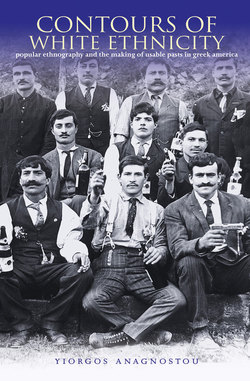Читать книгу Contours of White Ethnicity - Yiorgos Anagnostou - Страница 11
ОглавлениеCHAPTER TWO
Whither Collective Ethnic Identities?
White Ethnics and the Slippery Terrain of European Americanness
The twilight [of ethnicity] metaphor also allows for the occasional flare-ups of ethnic feelings and conflicts that give the illusion that ethnicity is reviving, but are little more than flickers in the fading light.
—Richard Alba, Italian Americans: Into the Twilight of Ethnicity
From “power feminism” to libertarian gay rights to assertions of “ghetto nihilism,” we are awash in a petit bourgeois politics that simultaneously caresses the better-off female, gay, and/or minority self while consigning its working-class and impoverished sisters and brothers to their “richly deserved” misery, lecturing them, for all the world like some twentieth-century Gradgrind, to pull themselves up by their bootstraps.
—Micaela di Leonardo, “White Ethnicities, Identity Politics, and Baby Bear’s Chair”
WHAT IS HAPPENING to American white ethnicities in the era of multiculturalism? A significant number of scholars tend to think about white ethnicity in apocalyptic terms, writing, if not of its imminent extinction, certainly of its dramatic weakening. Key words such as “atrophy,” “twilight,” “superficiality,” and “thinness” increasingly frame a research perspective that is unwilling to probe beyond the vocabulary of white ethnic cultural decline, the celebratory display of symbols in parades and festivals, forgetting, and the dimming of tradition. White ethnicities are seen as attenuated to such a degree as to become fleeting and shallow. Their communities are portrayed as verging on dissolution, a monumental fragmentation that will lead to the proliferation of an infinite variety of private and tenuous ethnic identities. And the fusion of distinct ethnic identities of Americans of European ancestry into a (white) European American identity is predicted, inevitably diminishing the importance of particular ethnic collectives. Whereas elsewhere in scholarship racial minorities are represented as embodying richly textured cultural lives, white ethnics are made to stand for a transparent people on the verge of losing culture.
The work of Richard Alba (1990), one of the most influential sociologists of white ethnicity in the United States, exemplifies a powerful contour of this scholarship. Alba argues that distinct white-hyphenated identities are undergoing a dramatic transformation, morphing into an emergent panethnic European American identity. Crucial to this argument is the notion that high degrees of cultural loss among ethnics of European ancestry have dissolved the differences that have historically separated them from one other—say Italian Americans from Polish Americans. This collapse of ethnic boundaries makes possible their assimilation into an emerging European American group, which is brought together by a shared narrative of immigrant hardships followed by a hard-earned experience of social and economic mobility.
Alba identified and sought to tackle a “paradoxical divergence” in the expression of white ethnicity (290). On the one hand, his findings pointed to the “long-run and seemingly irreversible decline of objective ethnic differences” (ibid.) among populations of European ancestry, a process he explained as the end product of inexorable acculturation and structural assimilation. The resulting cultural dilution of ethnicity becomes sociologically quantifiable, measured in high rates of language loss, the diminishment of ethnically marked behavior, and the “great extent and ease of intermarriage,” which tellingly reveals “the growing extent of social integration among persons with European ancestry” (291).1 On the other hand, the sociologist is confronted with recurrent evidence underlining “the continuing subjective importance of ethnic origins to many white Americans” (290). Although white ethnics have departed radically from the immigrant generation’s behavioral patterns, they continue to observe family-based ethnic traditions, explore roots, undertake trips to places of ancestral origins, and voluntarily participate in the activities of ethnic associations.
What is more, the persistence of individual ethnic identity correlates positively with high levels of education and social mobility. “[I]ncreasing education tends to heighten awareness of ethnic background,” Alba writes (308), accounting for this persistence as the outcome of rational choice. He suggests that ethnic identification among mobile, highly educated white Americans works beneficially “as a form of cultural capital” (ibid.) in that it enhances an individual’s economic and social interests by facilitating access to social networks of power. This position “presumes that ethnic symbols and references can be of use in the complex signaling by which individuals establish relationships to one another” (ibid). Its salience in upper-class circles requires that such an identity “need not occupy more than a small portion of the identity ‘masks’ individuals present to others, and need not be deeply felt” (308). Assimilated white ethnics do not return to behavioral ethnicity; instead they display a romanticized, nostalgic, and sentimental connection to it, a nonthreatening association that carries no social stigma whatsoever. In other words, total assimilation, in the manner predicted by traditional assimilation theory, has not occurred. What has taken place instead is a radical transformation of old-style identities and communities (determined by an ethnic culture) into voluntarily chosen, malleable ones that weaken and even situationally dissolve internal cultural boundaries among whites.2
Because the overall thesis of his landmark book Ethnic Identity: The Transformation of White America rests on the notion of a tenuous ethnic identity, Alba expends a great deal of intellectual labor to establish white ethnic identities as weak in salience, ultimately shallow, and superfluous. He argues that the dissolution of ethnically based social structures that have historically shaped and sustained collective identities results in a fundamental transformation: the formation of largely private, family-centered identities, whose extreme variability makes the maintenance of meaningful ethnic collectives impossible. The weakening and decentering of the “available collective expressions of ethnicity” or the “supply side of ethnicity” (303) results in ethnic fragmentation and gives rise to highly personal and culturally tenuous identities. The prevalence of voluntary (and fragile) ethnic affiliation comes about as a result of social disintegration, as ethnic structures determining identity recede or even disappear from the public sphere.
